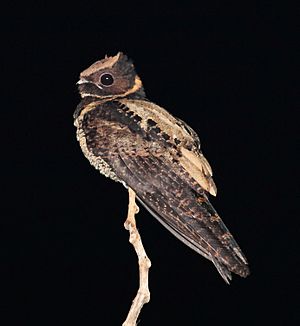Great eared nightjar facts for kids
Quick facts for kids Great eared nightjar |
|
|---|---|
 |
|
| L. m. macropterus from Sulawesi | |
| Conservation status | |
| Scientific classification | |
| Genus: |
Lyncornis
|
| Species: |
macrotis
|
| Synonyms | |
|
|
The great eared nightjar (Lyncornis macrotis) is a very interesting bird. It belongs to the nightjar family, known as Caprimulgidae. You can find this bird in parts of southwest India and across Southeast Asia. This large nightjar has long wings with stripes and a striped tail. It also has long "ear-tufts" on its head, which often lie flat. It has a white band on its throat, but no white markings on its wings or tail.
Contents
About the Great Eared Nightjar
The great eared nightjar is the biggest bird in its family when it comes to length. It can grow to be about 31 to 41 centimeters (12 to 16 inches) long. Male nightjars usually weigh around 131 grams (4.6 ounces). Female nightjars are a bit heavier, weighing about 151 grams (5.3 ounces). This makes it the second heaviest bird in its family.
Where They Live and Their Home
These birds live in South Asia and Southeast Asia. You can find them in places like the Western Ghats and Sri Lanka, Bangladesh, India, Indonesia, Laos, Malaysia, Myanmar, the Philippines, Thailand, and Vietnam. Their natural habitat (which means their home environment) is usually warm, wet lowland tropical forests.
How They Behave
Just like other nightjars, these birds are most active when the sun goes down and during the night. They have a special call that helps identify them. It sounds like a sharp tsiik, then a short pause, followed by a two-syllable sound like ba-haaww.
Reproduction and Life Cycle
When it's time to have babies, the great eared nightjar makes a simple nest. It's just a shallow dip on the ground. The female usually lays only one egg. The baby chick is very well hidden. Its colors help it blend in perfectly with the leaf litter on the forest floor.
How Scientists Named Them
The great eared nightjar was officially described by a scientist named Nicholas Aylward Vigors in 1831. He was an Irish zoologist. He studied a bird sample found near Manila in the Philippines. Vigors gave it the scientific name Caprimulgus macrotis.
This bird used to be in a different group called Eurostopodus. But in 2010, scientists did a study using molecular phylogenetics (which looks at genetic differences). They found that the great eared nightjar was quite different from other birds in the Eurostopodus group. So, it was moved to a new group called Lyncornis.
The name Lyncornis comes from ancient Greek words. Lunx or lunkos means "lynx" (a type of wild cat), and ornis means "bird." The second part of its name, macrotis, also comes from ancient Greek. Makrōtēs means "long-eared," from makros meaning "long" and ous or ōtos meaning "ear." This name fits well because of their long ear-tufts!
Different Types of Great Eared Nightjars
Scientists recognize five different types, or subspecies, of the great eared nightjar. These are slightly different groups within the same species, often found in different areas:
- L. m. cerviniceps described by John Gould in 1838 – Found from Bangladesh and northeastern India to southern China, Indochina, and the northern Malay Peninsula.
- L. m. bourdilloni described by Allan Octavian Hume in 1875 – Found in southwestern India.
- L. m. macrotis described by Nicholas Aylward Vigors in 1831 – Found in the Philippines (but not the far west of Visayas, the Palawan group, or the Sulu Archipelago).
- L. m. jacobsoni described by George Junge in 1936 – Found on Simeulue island (west of north Sumatra).
- L. m. macropterus described by Charles Lucien Bonaparte in 1850 – Found on Sulawesi, Sangihe and Talaud Islands (northeast of Sulawesi), Banggai, and Sula Island (east of Sulawesi).
Images for kids




